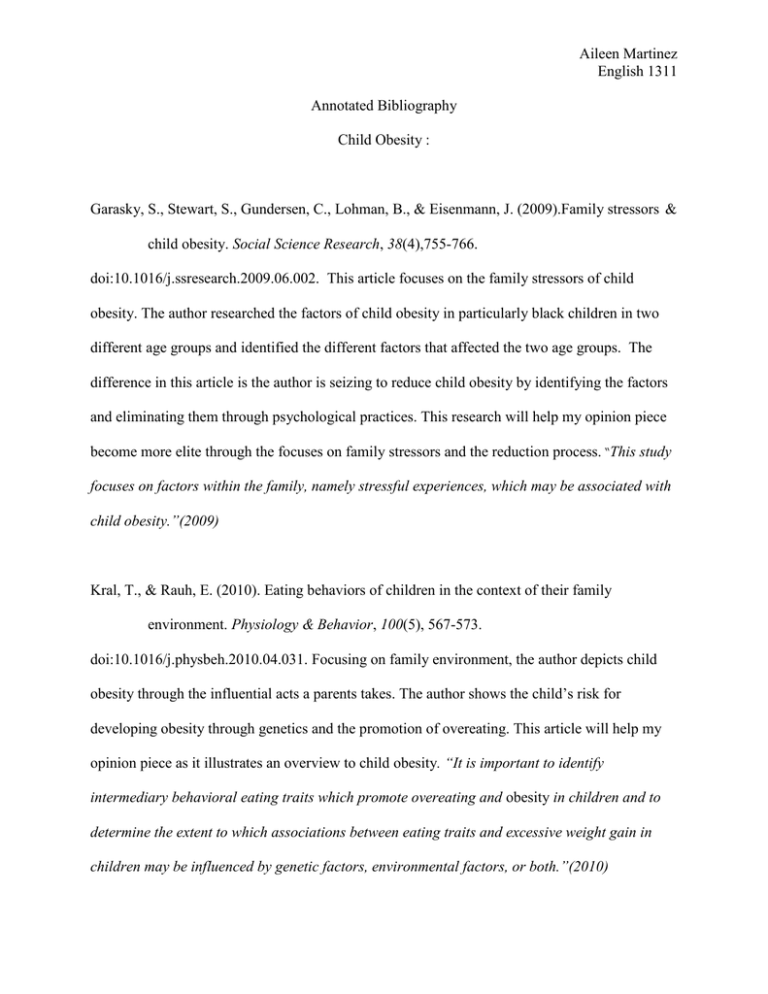Annotated bibliography
advertisement

Aileen Martinez English 1311 Annotated Bibliography Child Obesity : Garasky, S., Stewart, S., Gundersen, C., Lohman, B., & Eisenmann, J. (2009).Family stressors & child obesity. Social Science Research, 38(4),755-766. doi:10.1016/j.ssresearch.2009.06.002. This article focuses on the family stressors of child obesity. The author researched the factors of child obesity in particularly black children in two different age groups and identified the different factors that affected the two age groups. The difference in this article is the author is seizing to reduce child obesity by identifying the factors and eliminating them through psychological practices. This research will help my opinion piece become more elite through the focuses on family stressors and the reduction process. “This study focuses on factors within the family, namely stressful experiences, which may be associated with child obesity.”(2009) Kral, T., & Rauh, E. (2010). Eating behaviors of children in the context of their family environment. Physiology & Behavior, 100(5), 567-573. doi:10.1016/j.physbeh.2010.04.031. Focusing on family environment, the author depicts child obesity through the influential acts a parents takes. The author shows the child’s risk for developing obesity through genetics and the promotion of overeating. This article will help my opinion piece as it illustrates an overview to child obesity. “It is important to identify intermediary behavioral eating traits which promote overeating and obesity in children and to determine the extent to which associations between eating traits and excessive weight gain in children may be influenced by genetic factors, environmental factors, or both.”(2010) Aileen Martinez English 1311 Michael, L. D. (1998). Determining Fatness. In Child Obesity (pp. 9-10). New York: Springer Publishing Company.: Determining Fatness: In this section, the author is explaining how to identify and determine the degree of fatness among children. This is a very crucial element for my paper as it will provide my audience with an operational definition of obesity and what level of fatness I’m basing my research results on. This section goes on to analyze the difference between two boys who are similar in weight, height and age, but completely differ when compared to their physical activity. “Their moderately high weights, though equal, reflect different levels of fatness.”(p.9) The author discusses the term overweight and how different researchers place their degree of excess at a certain sort of standard. Michael, L. D. (1998). Class, Race, Family Connections. In Child Obesity (pp. 22-24). New York. Springer Publishing Company.: Class, Race, Family Connections: The author in this particular section explains where we can find the “fat” children in society. They compare socioeconomic status to the obesity level of a child. “The obese, as measured by weight for height, have a lower socioeconomic status (income, occupation, rent) that do the nonobese.”(p.23) This section will support my argument as I’m comparing financial status to the impartations of child obesity. The author depicts obesity using the acculturation measure of social class affiliation. He explains a research case by Garb & Stunkard (1975) regarding social class and obesity. This section will support a great deal of my opinion piece as it will put into play the different concepts that affect child obesity that have to do with financial stability and level. Aileen Martinez English 1311 Michael, L. D. (1998). Genetic Connections. In Child Obesity (pp. 35-36). New York. Springer Publishing Company.: Genetic Connections: Here now, the author focuses on a possible factor that can contribute to the obesity of a child on a more scientific note. They discuss the probability of a child being obese before they have been born by simply taking a look at the parents. “Significant, however, was that mothers and children resembled one another in excess weight; More overweight youngsters had overweight mothers than did non-overweight youngsters.”(p.35) The author shows the relationship between the parents and how this can influence the child; they discuss the connection of foster children and their foster parents. If a child was raised by an overweight mother or father the possibility of a child being overweight was greater than of the child being raised by a non-overweight parent. This theory highlights the Nature V. Nurture virtue as genetics and environmental sciences go against one another. This section will give me a better understanding when I’m composing my opinion piece as it will give me an alter view of child obesity oppose to the typical psychological factors. Oi Ling, W. (2010). Childhood Obesity in a Chinese Family Context. Contemporary Family Therapy: An International Journal, 32(3), 335-347. doi:10.1007/s10591-010-9121-7. This author takes a different approach to child obesity as he takes his research from a chinese families perspective. He centers his approach on family interaction and argument resolution in 8 different families. This can help me take a counter approach to my argument as I will add family interaction to financial status. “The significant role that may be played by the extended family in contributing to a child’s obesity, as well as female power dominance in the domestic sphere are considered.”(2010) The advantage to using a different culture family will be the different perspectives of child obesity and realizing that child obesity is a worldwide issue. Aileen Martinez English 1311 Olstad, D., & McCargar, L. (2009). Prevention of overweight and obesity in children under the age of 6 years. Applied Physiology, Nutrition & Metabolism, 34(4), 551-570. doi:10.1139/H09-016. This article gives a different perspective on child obesity as it demonstrates the parental control on their child’s health. It describes an insight to the parent’s power over the child’s daily activities and eating choices. The author talks about the obesity rate in general and tries to emphasize on the affecting factors of child obesity such that an obesity prevention strategies needs to be enforced. “Intrauterine life, infancy, and the preschool years may all include critical periods that program the long-term regulation of energy balance, and therefore obesity-prevention strategies should be initiated in utero and continue throughout childhood and adolescence.”(2009) This article will give me great foundation for my opinion piece as it supports my argument of child obesity worldwide and the factors. These sources I have cited above will add to the sophistication of my opinion piece and will create a better understanding to my audience. These sites and books will create larger background knowledge and allow me to have greater authority to write about child obesity.








